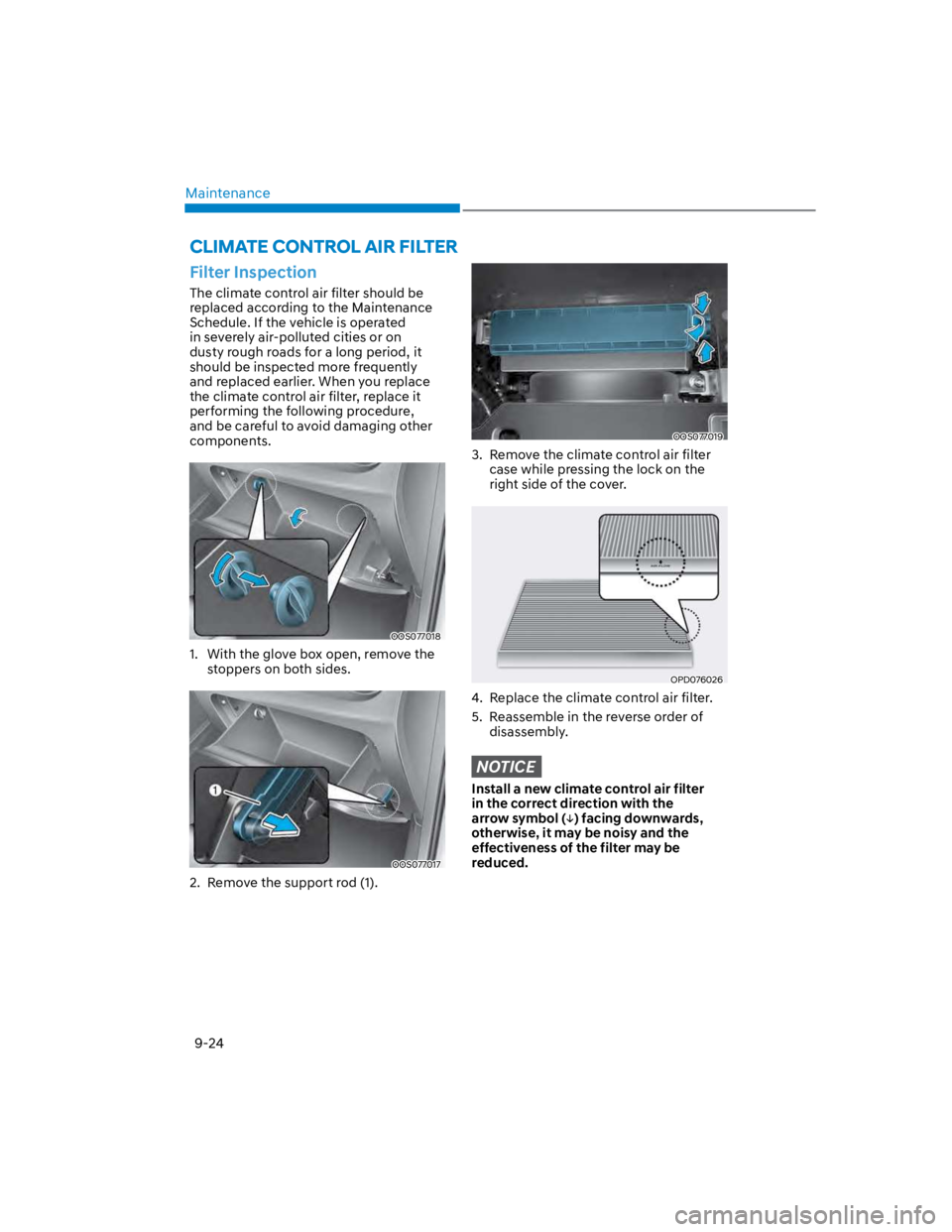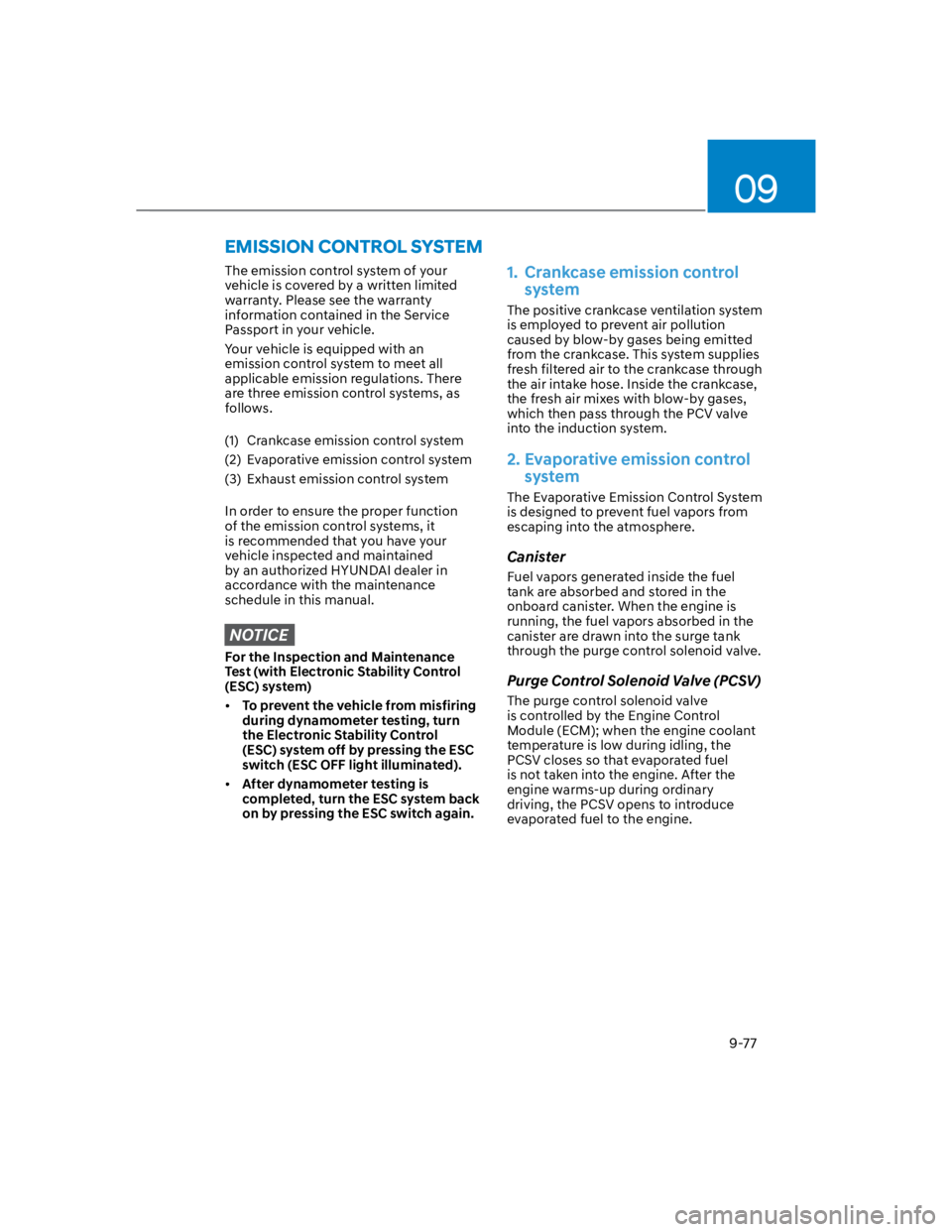2022 HYUNDAI KONA air filter
[x] Cancel search: air filterPage 510 of 579

Maintenance
9-24
CLIMATE CONTROL AIR FILTER
Filter Inspection
The climate control air filter should be
replaced according to the Maintenance
Schedule. If the vehicle is operated
in severely air-polluted cities or on
dusty rough roads for a long period, it
should be inspected more frequently
and replaced earlier. When you replace
the climate control air filter, replace it
performing the following procedure,
and be careful to avoid damaging other
components.
OOS077018
1. With the glove box open, remove the
stoppers on both sides.
OOS077017
2. Remove the support rod (1).
OOS077019
3. Remove the climate control air filter
case while pressing the lock on the
right side of the cover.
OPD076026
4. Replace the climate control air filter.
5. Reassemble in the reverse order of
disassembly.
NOTICE
Install a new climate control air filter
in the correct direction with the
arrow symbol () facing downwards,
otherwise, it may be noisy and the
effectiveness of the filter may be
reduced.
Page 563 of 579

09
9-77
The emission control system of your
vehicle is covered by a written limited
warranty. Please see the warranty
information contained in the Service
Passport in your vehicle.
Your vehicle is equipped with an
emission control system to meet all
applicable emission regulations. There
are three emission control systems, as
follows.
(1) Crankcase emission control system
(2) Evaporative emission control system
(3) Exhaust emission control system
In order to ensure the proper function
of the emission control systems, it
is recommended that you have your
vehicle inspected and maintained
by an authorized HYUNDAI dealer in
accordance with the maintenance
schedule in this manual.
NOTICE
For the Inspection and Maintenance
Test (with Electronic Stability Control
(ESC) system)
To prevent the vehicle from misfiring
during dynamometer testing, turn
the Electronic Stability Control
(ESC) system off by pressing the ESC
switch (ESC OFF light illuminated).
After dynamometer testing is
completed, turn the ESC system back
on by pressing the ESC switch again.
1. Crankcase emission control
system
The positive crankcase ventilation system
is employed to prevent air pollution
caused by blow-by gases being emitted
from the crankcase. This system supplies
fresh filtered air to the crankcase through
the air intake hose. Inside the crankcase,
the fresh air mixes with blow-by gases,
which then pass through the PCV valve
into the induction system.
2. Evaporative emission control
system
The Evaporative Emission Control System
is designed to prevent fuel vapors from
escaping into the atmosphere.
Canister
Fuel vapors generated inside the fuel
tank are absorbed and stored in the
onboard canister. When the engine is
running, the fuel vapors absorbed in the
canister are drawn into the surge tank
through the purge control solenoid valve.
Purge Control Solenoid Valve (PCSV)
The purge control solenoid valve
is controlled by the Engine Control
Module (ECM); when the engine coolant
temperature is low during idling, the
PCSV closes so that evaporated fuel
is not taken into the engine. After the
engine warms-up during ordinary
driving, the PCSV opens to introduce
evaporated fuel to the engine.
EMISSION CONTROL SYSTEM
Page 565 of 579

09
9-79
Your vehicle is equipped with a catalytic
converter emission control device.
To prevent damage to the catalytic
converter and to your vehicle, take the
following precautions:
Use only UNLEADED FUEL for
gasoline engines.
Do not operate the vehicle when
there are signs of engine malfunction,
such as misfire or a noticeable loss of
performance.
Do not misuse or abuse the engine.
Examples of misuse are coasting with
the engine off and descending steep
grades in gear with the engine off.
Do not operate the engine at high
idle speed for extended periods (5
minutes or more).
Do not modify or tamper with any
part of the engine or emission control
system. We recommend that all
inspections and adjustments are
made by an authorized HYUNDAI
dealer.
Avoid driving with an extremely low
fuel level.
Running out of fuel could cause the
engine to misfire, damaging the
catalytic converter.
Gasoline Particulate Filter (GPF)
(if equipped)
Gasoline Particulate Filter (GPF) system
removes the soot in the exhaust gas.
The GPF system automatically burns
(or oxidizes) the accumulated soot in
accordance with driving situations,
unlike a disposable air filter.
In other words, the accumulated soot is
automatically purged out by the engine
control system and by the high exhaust-
gas temperature at normal/ high driving
speeds. However, when the vehicle is
continually driven at repeated short
distances or driven at low speed for a
long time, the accumulated soot may
not be automatically removed because
of low exhaust gas temperature. In this
case, the accumulated soot may reach
a certain amount regardless of the soot
oxidization process, then the GPF lamp
() will illuminate.
The Gasoline Particulate Filter (GPF)
lamp stops illuminating, when the
driving speed exceeds 50 mph (80 km/h)
with engine rpm 1,500 ~ 4,000 and the
gear in the 3rd position or above for
approximately 30 minutes.
When the GPF lamp starts to blink or
the warning message “Check exhaust
system” pops up even though the vehicle
was driven as mentioned above, have the
GPF system checked by an authorized
HYUNDAI dealer.
With GPF lamp blinking for an extended
period of time, it may damage the GPF
system and lower the fuel economy.
CAUTION
We recommend you to use only the
regulated gasoline fuels, when your
vehicle is equipped with the GPF
system.
When you use other gasoline fuels
which contain unspecified additives,
they may damage the GPF system and
cause exhaust emission problems.
Page 568 of 579

Index
I-2
A
Accessing your vehicle .......................................................................................... 5-4
Hyundai Digital Key ........................................................................................ 5-15
Immobilizer system .......................................................................................... 5-14
Remote key......................................................................................................... 5-4
Smart key............................................................................................................ 5-7
Air bag - supplemental restraint system .............................................................. 3-41
Additional safety precautions ........................................................................... 3-62
Air bag warning labels ..................................................................................... 3-62
How does the air bags system operate?............................................................ 3-46
Occupant Classification System (OCS) ........................................................... 3-50
SRS care ........................................................................................................... 3-61
What to expect after an air bag inflates ............................................................ 3-49
Where are the air bags? .................................................................................... 3-43
Why didn’t my air bag go off in a collision? ................................................... 3-56
Air cleaner ........................................................................................................... 9-23
Filter replacement ............................................................................................ 9-23
Air conditioning system....................................................................................... 2-12
Appearance care................................................................................................... 9-68
Exterior care ..................................................................................................... 9-68
Interior care ...................................................................................................... 9-74
Automatic climate control system ....................................................................... 5-89
Automatic heating and air conditioning ........................................................... 5-90
Manual heating and air conditioning................................................................ 5-90
System maintenance ......................................................................................... 5-96
System operation .............................................................................................. 5-94
B
Before driving ........................................................................................................ 6-4
Before entering the vehicle ................................................................................ 6-4
Before starting .................................................................................................... 6-4
Blind-Spot Collision-Avoidance Assist (BCA) .................................................. 7-35
Blind- Spot Safety system malfunction and limitation .................................... 7-44
Blind- Spot Safety system operation ................................................................ 7-39
Blind- Spot Safety system settings ................................................................... 7-37
Page 569 of 579

I
I-3
Brake fluid ........................................................................................................... 9-21
Checking the brake fluid level ......................................................................... 9-21
Braking system .................................................................................................... 6-26
Anti-lock Brake System (ABS) ........................................................................ 6-36
Auto Hold ......................................................................................................... 6-33
Disc brakes wear indicator ............................................................................... 6-26
Downhill Brake Control (DBC) ...................................................................... 6-42
Electronic Parking Brake (EPB) ..................................................................... 6-28
Electronic Stability Control (ESC)................................................................... 6-38
Good braking practices..................................................................................... 6-45
Hill-Start Assist Control (HAC) ...................................................................... 6-41
Parking Brake ................................................................................................... 6-27
Power-assist brakes .......................................................................................... 6-26
Vehicle Stability Management (VSM) ............................................................ 6-40
Bulb wattage ........................................................................................................ 2-10
C
California perchlorate notice ............................................................................... 9-80
Child Restraint System (CRS) ............................................................................. 3-30
Children Always in the Rear ............................................................................ 3-30
Installing a Child Restraint System (CRS)....................................................... 3-33
Selecting a Child Restraint System (CRS) ....................................................... 3-31
Climate control additional features.................................................................... 5-103
Automatic Ventilation..................................................................................... 5-103
Inside air circulation while operating the washer fluid ................................. 5-103
Sunroof Inside Air Recirculation.................................................................... 5-103
Climate control air filter ...................................................................................... 9-24
Filter Inspection................................................................................................ 9-24
Consumer information ......................................................................................... 2-17
Cruise Control (CC) ............................................................................................ 7-60
Function operation ........................................................................................... 7-60